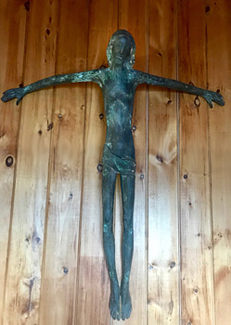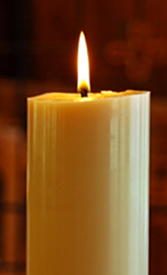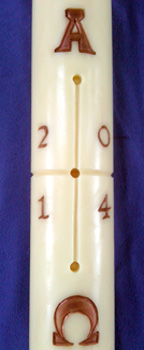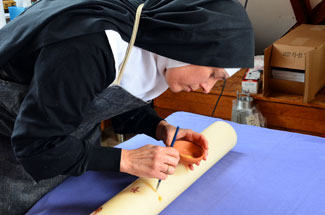
 |
|
|

Alone worthy have you been to bear the ransom of the ages.
And as if preparing a harbor, and as if a seaman for the shipwrecked world, With His sacred gore anointed, poured forth on the lamb’s body. From Good Friday Hymn, Crux Fidelis, translation by Joseph T. Moller
Go to Triduum and Easter Liturgy Schedule.  We are privileged to offer original translations of the hymns for Passiontide and Good Friday as well as the Easter vigil proclamation, the Exultet. Latin texts were translated by Abbey friend and classicist, Joseph T. Moller. We are privileged to offer original translations of the hymns for Passiontide and Good Friday as well as the Easter vigil proclamation, the Exultet. Latin texts were translated by Abbey friend and classicist, Joseph T. Moller. Vexilla Regis was written by Venantius Fortunatus (530-609) and is considered one of the greatest hymns of the liturgy. The hymn is sung at Vespers during Passiontide. Crux Fidelis, is sung by our monastic and Oblate choirs and choirs throughout the world during the Adoration of the Cross Ceremony on Good Friday. The hymn was composed by Venantius Fortunatus in the sixth century. Included here are the translator's notes, with the history of the hymns as well as the etymology of key words of the text, This translation offers a profound meditation on the birth, life and sacrifice of our Redeemer. May it enrich your prayer this Holy Week for our "shipwrecked world". HYMN FOR PASSIONTIDE—VEXILLA REGIS
Translator's Notes This translation is of the text in the Monastic Diurnal. The original hymn was written by Venantius Fortunatus in the 6th century on the occasion of a procession bearing a relic of the True Cross sent to St. Radegund, Queen of the Franks by the Emperor Justin II. Since the time of Fortunatus the hymn has been revised several times and there are textual variants as well. In the 17th century under Pope Urban the hymn was modified to conform with classical prosody. The original text was restored under Pope Pius X. This was most likely the version that was used in the Roman liturgy as the hymn at Vespers from the Saturday before Holy Week and on the days of Holy Week and on Good Friday. Vexilla and Mysterium Are the banners (Vexilla) the sacraments or the emblems of the Passion: scourge, crown of thorns, etc.? The image is drawn from a military metaphor. Vexilla were the banners of the Roman legions; after Constantine with crosses at the top. In Christian liturgical processions starting in late antiquity, they were metal poles with cross pieces to which banners were attached (as in some parish liturgies today.) So the first line is a concrete visual as well as a metaphorical image of the procession. Mysterium was a military emblem, so it has that connotation as well as that of a mystery of our faith. HYMN FOR GOOD FRIDAY LITURGY—CRUX FIDELIS
This hymn was composed by Venantius Fortunatus in the sixth century. He wrote at a time when Latin poetry was in transition from the quantitative verse of classical forms to the accentual meters of later Latin verse. The Gregorian chant perfectly captures the profound meaning of its words as well the haunting cadence of its trochaic tetrameter. The entire hymn is sung on Good Friday during the adoration of the cross in a unique arrangement: What was originally the eighth stanza is sung first. Each subsequent stanza is followed alternately by either the first four lines or the last two lines of the eighth stanza as a kind of refrain. “The work of our salvation…” This stanza and the next stanza refer to the legend that Seth obtained a branch of the tree from which Eve, tempted by Satan, ate the forbidden fruit. He planted it on Golgotha because Adam was buried there. From that tree in the course of salvation history the ark of the covenant was made, the pole on which the brazen serpent was lifted up, and finally the cross. Thus the tree of damnation was transformed into the tree of redemption. “…in the folds…” This stanza refers both to Christ’s birth and perhaps his burial as well. “And as if preparing a harbor and as if a seaman…” Perhaps a reference to Noah and the ark or perhaps better interpreted along the lines of St. Augustine’s trope as the cross being the only ‘ship’ that will carry us from this world to the next. (Translations of Vexilla Regis and Crux Fidelis and translator's notes courtesy of Joseph T. Moller: Copyright © 2018 The Abbey of Regina Laudis. All rights reserved.) We are also blessed to have artists and crafts women whose works draw us into the mysteries we celebrate. We offer here visuals and descriptions of the sacramentals that have been created, such as the Pascal candle and sculptures of life-sized sheep inspired by the days of Holy Week.
THE DAYS OF HOLY WEEK REPRESENTED IN LIFE-SIZED WELDED STEEL SHEEP A procession of life-size welded steel sheep can be seen leading visitors into the Abbey Church or in other locations on the Abbey grounds. These were created by Mother Praxedes Baxter as the basis of her final project for her Masters Degree in Fine Arts at Michigan State University. They are made from cast cement and welded steel, many pieces of which are recycled from a broken, rusty water tank. Inspired by the liturgy of HOLY WEEK, the sheep represent the movement of the Lamb of God through his Passion, Death and Resurrection. Each day of Holy Week a particular mystery is highlighted in the Scripture Reading or the Collects of the Mass and the texts of the Divine Office. • The Saturday before Palm Sunday, known as Commitment Saturday presents Jesus saying to His disciples, “I must go to Jerusalem,” publicly stating His unflinching commitment to His redemptive mission. • Palm Sunday brings us into the mystery of Procession as we witness Christ’s triumphal entrance into Jerusalem. • The Gospel for Monday of Holy Week presents Mary Magdalene who bathes the feet of Jesus with her tears and dries them with her hair, embodying the mystery of Intimate Extravagance. • The collect at Mass of Tuesday of Holy Week accents Per Agere or Compulsion to Complete the Mission as Christ proceeds in His inexorable movement toward the Father. • Aloneness is the mystery of Wednesday of Holy Week; Christ stands alone in the face of His Passion. • Holy Thursday celebrates Body Given when Christ gives His Body and Blood to the disciples through the bread and wine of the Last Supper. • The theme of Good Friday Non est Lex is taken from the Lamentations of the prophet Jeremiah: the suffering, crucifixion and death of Jesus in His innocence fall outside the boundaries of rational law. • We are immersed in the mystery of Night on Holy Saturday as Christ lies dead in the darkness of the tomb. • Joyfully we enter the mystery of Miracles on Easter Sunday. "He has risen from the dead. Alleluia!"
Click on photographs in the sidebar on the right to see full size and details of the sheep sculptures.
THE EXSULTET At the beginning of the Easter Vigil we have the Liturgy of Light. An immense Easter fire is lit in the parking lot of our church Jesu Fili Mariae and that fire is used to light the newly-made Paschal candle. As we follow the priest and servers into the darkened church, Lumen Christi is proclaimed three times. The flame from the Paschal candle is shared from taper to taper held by each person in the church. By the light of these tapers the ancient Easter Proclamation the Exsultet is sung in Latin. We are pleased to share this beautiful English translation of the Exsultet by classicist and Abbey friend, Joseph T. Moller. Going back to critical Latin sources, Joseph offers us a fresh poetic expression of the text, rather then a conventional translation. His unique use of rhythm and word ordering, reminiscent of the poet Gerard Manley Hopkins, grabs our attention: ...the earth instruck with the rays flashing of such a light! We are grateful to Joseph for opening our ears and hearts more profoundly to the wonder of this Blessed Night. ENGLISH TRANSLATION  Exult now the Angelic Throng in the heavens: let the divine mysteries exult: and for such a king in his victory, let the trumpet insound salvation. Rejoice also the earth instruck with the rays flashing of such a light; and with the eternal king’s splendor alight, from the whole world, let her feel the darkness sent away. Joyful also be Mother Church, with such a light adorned, flashing brilliancies: and great with the voicings of the people let this church leap re-echoing. Wherefore, you standing here, dear brothers, to this so wondrous brilliance of holy night, together with me, I ask, Almighty God’s mercy invoke. That he who, not through my merits, has deigned me within the number of the Levites to ingather: the brilliance of his light pouring out may this candle full in praise perfect. Exult now the Angelic Throng in the heavens: let the divine mysteries exult: and for such a king in his victory, let the trumpet insound salvation. Rejoice also the earth instruck with the rays flashing of such a light; and with the eternal king’s splendor alight, from the whole world, let her feel the darkness sent away. Joyful also be Mother Church, with such a light adorned, flashing brilliancies: and great with the voicings of the people let this church leap re-echoing. Wherefore, you standing here, dear brothers, to this so wondrous brilliance of holy night, together with me, I ask, Almighty God’s mercy invoke. That he who, not through my merits, has deigned me within the number of the Levites to ingather: the brilliance of his light pouring out may this candle full in praise perfect. Truly worthy and just it is, the invisible God, Father Almighty and His only begotten Son, our Lord Jesus Christ, with the whole heart and affection of mind, in ministration of voice and praise to persound. Who for us, Adam’s debt to the eternal Father, has absolved: and the old impediment of impious guilt with His blood in compassionate honor has wiped away. These are indeed the paschal feasts, in which truly that Lamb is slain, by whose blood the doorposts of the faithful are consecrated. Truly worthy and just it is, the invisible God, Father Almighty and His only begotten Son, our Lord Jesus Christ, with the whole heart and affection of mind, in ministration of voice and praise to persound. Who for us, Adam’s debt to the eternal Father, has absolved: and the old impediment of impious guilt with His blood in compassionate honor has wiped away. These are indeed the paschal feasts, in which truly that Lamb is slain, by whose blood the doorposts of the faithful are consecrated.This is the night, in which first our fathers, the sons of Israel, led out of Egypt, the Red Sea dry-trod you made to cross. This therefore is the night, which has the darkness of sinners with the illumination of a pillar of light purged. This is the night, which today, throughout the world, those believing in Christ, from the vices of the times and the darkness of sin, gathers apart, restores to grace, joins to holiness. This is the night, in which torn down were the chains of death and Christ, from Hell, the victor ascended. Nothing indeed to us in birth would there have been of benefit, except that it brought us to be redeemed. O the wonder that you deemed us worthy of your compassion. O the inconceivable love beyond love, choosing, caring: the slave to ransom, the son you handed over. O surely the necessary sin of Adam which by Christ’s death was blotted out. O happy fault which merited to have such and so great a redeemer.  O truly blessed night, which alone merited to know the time and the hour in which Christ from Hell arose. This is the night, of which it is written: And the night like the day will be lit up: And night, my light in my joy. Therefore the sanctifying act of this night puts to flight crime, guilt it washes away: and it restores innocence to the fallen and to the sorrowful joy. It puts to flight hatreds, harmony it readies, it bends power to mercy. O truly blessed night, which alone merited to know the time and the hour in which Christ from Hell arose. This is the night, of which it is written: And the night like the day will be lit up: And night, my light in my joy. Therefore the sanctifying act of this night puts to flight crime, guilt it washes away: and it restores innocence to the fallen and to the sorrowful joy. It puts to flight hatreds, harmony it readies, it bends power to mercy.In this night of grace, therefore, accept, Holy Father, the evening sacrifice of this incense: which to you in the solemn offering of this candle, through the hands of her ministers, from the work of the bees, Holy Church renders. But now already we experience the proclamation spreading of this column of light, which to the honor of God shining red in fire burns, which though divided into parts, still not diminished, experiences no loss of the light borrowed from it. For it is fed by the liquid wax, which into the substance of this precious candle the mother bee has brought forth. O truly blessed night which despoiled the Egyptians, enriched the Hebrews. Night in which to things earthly, the heavenly; and to things human, the divine are joined.  We therefore pray thee, Lord: that this your candle to the honor of your name consecrated, the darkness of this night to destroy, unfailingly persevere. And may it, in the fragrance of its sweetness accepted, with heavenly light-bearers be mingled. Its flames may the morning star find. That morning star light bearer, I say, which knows no setting. He, who returned from hell, brought to humankind serene light. We therefore pray thee, Lord: that this your candle to the honor of your name consecrated, the darkness of this night to destroy, unfailingly persevere. And may it, in the fragrance of its sweetness accepted, with heavenly light-bearers be mingled. Its flames may the morning star find. That morning star light bearer, I say, which knows no setting. He, who returned from hell, brought to humankind serene light.We pray you therefore, Lord: that to us your family, and all the clergy, and your most devout people: together with our most blessed Pope and our Bishop, a time of peace yield, amidst these paschal joys, and under your assiduous protection, deign to rule, govern, and keep us. Look also to those who rule us in their power, and by the ineffable gift of your compassion and mercy, direct their thoughts to justice and peace, so that from earthly labors they may reach their heavenly home together with all your people. Amen. Download a copy of the English translation of the Exsultet. (Translation of the Exsultet courtesy of Joseph T. Moller: Copyright © 2005 The Abbey of Regina Laudis. All rights reserved.) OUR PASCHAL CANDLE  Our Paschal candle, made by Mother Lioba, is made from beeswax, 51% of which is from the Abbey hives. The candle measures 4 by 32 inches and weighs 15 pounds. She hand-carves the cross and the Greek letters Alpha and Omega, symbolic of Christ as the Beginning and the End. The symbols are highlighted with gold-tinted mica and the year on the candle is highlighted with bronze-tinted mica, a silicate mineral indigenous to Connecticut. The tapers for persons to hold during the Easter Vigil are hand-dipped 14 times—a daunting task when one considers that 200 tapers were made this year for the Vigil. We are blessed to have these beautiful sacramentals, made at the Abbey, to enrich our liturgies during Holy Week and Easter. Our Paschal candle, made by Mother Lioba, is made from beeswax, 51% of which is from the Abbey hives. The candle measures 4 by 32 inches and weighs 15 pounds. She hand-carves the cross and the Greek letters Alpha and Omega, symbolic of Christ as the Beginning and the End. The symbols are highlighted with gold-tinted mica and the year on the candle is highlighted with bronze-tinted mica, a silicate mineral indigenous to Connecticut. The tapers for persons to hold during the Easter Vigil are hand-dipped 14 times—a daunting task when one considers that 200 tapers were made this year for the Vigil. We are blessed to have these beautiful sacramentals, made at the Abbey, to enrich our liturgies during Holy Week and Easter.The Fabrication of the Paschal Candle and Tapers for the Easter Vigil
GALLERIES EASTER 2025 Our Paschal Candle and Sanctuary of Jesu Fili Mariae Candle made by Mother Lioba, flower arrangements by Sister Gregory
EASTER 2022 The Abbey’s candlemaker, Mother Lioba, inscribed our Paschal candle this year with blue and yellow, the national colors of Ukraine. As we behold its beauty, may our prayer echo that of the celebrant at the Easter Vigil as he embedded the incense into the paschal candle: By His holy and glorious wounds, may Christ the Lord guard us and protect us. And may He guard and protect the people of Ukraine in their Passion.
PENTECOST SUNDAY SEQUENCE The beautiful sequence Veni Sancte Spiritus is sung at Mass on Pentecost Sunday. We are pleased to offer you an original English translation by classicist and Abbey friend, Joseph T. Moller. Joseph includes the historical background to the sequence: This hymn clearly dates from the 12th century; its authorship has been the subject of scholarly discussion, but the Cistercian Archbishop of Canterbury, Stephen Langton, seems the most likely author. This sequence which became know as the 'golden sequence', is one of the few sequences that survived the reform of the liturgy after the Council of Trent. The poetic, theological, and musical felicities of this sequence make it one of the great masterpieces of Gregorian chant. Listen to the monastic choir sing the Sequence Veni Sancte Spiritus.
|